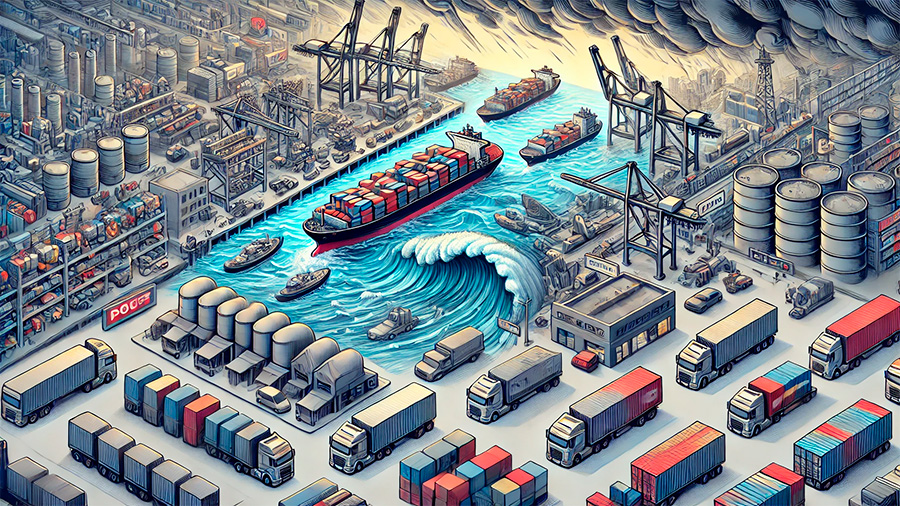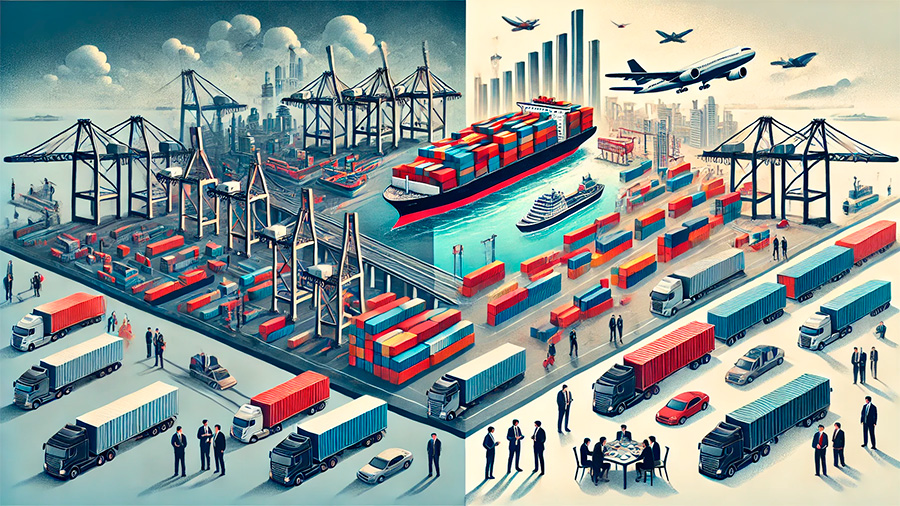Port strikes can have far-reaching and often underestimated consequences for the economy, especially in global supply chains where the efficient movement of goods is critical. When port workers go on strike, the delays and disruptions that follow create a ripple effect that impacts transportation, shipping costs, and the prices of everyday consumer goods. These hidden costs accumulate quickly, affecting businesses and consumers alike, as shipping times increase, and the price of goods rises.
This article explores how port strikes affect transportation, supply chains, and the cost of goods, highlighting the hidden costs that emerge during such labor disputes.
How Port Strikes Disrupt Global Transportation
Ports are essential gateways for international trade, handling the vast majority of goods that move across borders. A port strike can significantly disrupt transportation networks by halting or slowing the movement of goods. Ships unable to dock, unload, or load goods are forced to wait in queue, leading to backlogs and delays that affect supply chains worldwide. The longer the strike continues, the more severe the transportation disruption becomes, creating cascading effects across industries.
1. Increased Shipping Delays
During a port strike, the most immediate impact is felt in the form of shipping delays. Containers that were scheduled to be loaded or unloaded remain stranded at sea or on the docks. This causes delays in delivering products to markets, both domestic and international. Companies that rely on just-in-time inventory systems are particularly vulnerable, as the delays lead to inventory shortages and disruptions in production schedules.
Impact of port strikes on shipping delays:
- Longer transit times: Ships may be forced to wait offshore or divert to alternative ports, increasing overall shipping times.
- Supply chain bottlenecks: Delays in unloading goods lead to bottlenecks at ports and warehouses, slowing down the entire supply chain.
2. Higher Transportation Costs
When goods cannot move through ports efficiently, transportation costs inevitably rise. Shipping companies may face additional fuel costs as vessels are rerouted or forced to wait, and businesses may have to seek alternative modes of transportation, such as air freight, which is significantly more expensive. These increased costs are passed down the supply chain, ultimately affecting the price of consumer goods.
How port strikes drive up transportation costs:
- Rerouting expenses: Ships diverted to less congested ports incur higher fuel and logistical costs, driving up transportation expenses.
- Expensive alternatives: Businesses may switch to air freight or other costly alternatives to meet urgent delivery deadlines, further increasing costs.

The Hidden Costs in Supply Chains and Consumer Goods
The effects of port strikes extend beyond transportation, as supply chains become disrupted, leading to shortages and increased prices for goods. Everyday consumer products that rely on imported materials or components may see significant price hikes as businesses struggle to cover the additional costs associated with delayed shipments and disrupted supply chains. The hidden costs of port strikes accumulate quickly, affecting both retailers and consumers.
1. Product Shortages and Delayed Deliveries
When goods are delayed at ports, businesses face shortages of critical materials, components, or finished products. These shortages can result in empty store shelves, delayed product launches, or halted production lines, all of which can have significant financial consequences. Retailers and manufacturers must either wait for delayed goods to arrive or pay higher prices for expedited shipping alternatives.
Consequences of product shortages:
- Empty shelves: Retailers may run out of stock on popular items, leading to lost sales and frustrated customers.
- Production delays: Manufacturers that rely on imported components may face production slowdowns or stoppages, increasing operational costs.
2. Elevated Prices for Consumer Goods
As transportation and supply chain costs rise, businesses are forced to pass these costs onto consumers in the form of higher prices for goods. Everyday products, from electronics and clothing to household items and groceries, may become more expensive as companies seek to recoup their increased expenses. These price hikes contribute to inflationary pressures, affecting consumers’ purchasing power and overall economic stability.
How port strikes lead to higher prices:
- Increased production costs: Manufacturers facing higher costs for raw materials or components pass these expenses onto consumers through higher retail prices.
- Inflationary pressures: As the cost of goods rises, consumer prices increase, contributing to broader inflation in the economy.
The Long-Term Economic Impact of Port Strikes
The economic effects of port strikes are not limited to immediate delays and price hikes. Prolonged labor disputes can have long-term consequences for industries and economies, as businesses lose revenue, markets become destabilized, and global trade patterns shift. The longer a port strike lasts, the greater the damage to both domestic and international trade.
1. Loss of Revenue for Businesses
Businesses that rely on the timely delivery of goods are among the hardest hit by port strikes. Retailers may experience reduced sales due to inventory shortages, while manufacturers face increased production costs and delays. As businesses lose revenue, they may be forced to scale back operations, lay off workers, or delay expansion plans, all of which contribute to economic slowdown.
Financial impact on businesses during port strikes:
- Reduced sales: Retailers facing inventory shortages lose revenue as customers turn to competitors or delay purchases.
- Increased operational costs: Manufacturers pay higher costs to secure alternative supply routes, reducing profitability.
2. Shifts in Global Trade Patterns
Prolonged port strikes can lead to shifts in global trade patterns, as businesses seek to avoid future disruptions. Companies may choose to relocate their operations to regions with more stable labor relations or invest in alternative transportation hubs that are less vulnerable to strikes. Over time, this can erode the competitiveness of certain ports or regions, leading to long-term economic challenges for industries and workers.
How port strikes influence global trade patterns:
- Relocation of supply chains: Companies may move their supply chains to regions with more reliable infrastructure and labor stability.
- Investment in alternative hubs: Ports that are less prone to labor disputes may see increased investment, while strike-prone regions lose business.

Strategies to Mitigate the Impact of Port Strikes
While the effects of port strikes can be severe, businesses and governments can take proactive steps to mitigate the impact of labor disruptions. By developing contingency plans, diversifying transportation options, and improving labor relations, stakeholders can reduce the hidden costs of port strikes and ensure the continued flow of goods through global supply chains.
1. Developing Contingency Plans
Businesses that rely heavily on port infrastructure should develop contingency plans to prepare for potential strikes. This may involve securing alternative transportation routes, maintaining higher levels of inventory, or establishing relationships with multiple logistics providers. By preparing for disruptions, businesses can minimize the impact of port strikes on their operations.
Key elements of effective contingency plans:
- Alternative routes: Identifying alternative ports or transportation modes ensures that goods can continue to move during a strike.
- Inventory management: Maintaining higher stock levels can help businesses weather short-term disruptions without experiencing shortages.
2. Improving Labor Relations
Governments and businesses can work to improve labor relations at ports by addressing the root causes of labor disputes. By fostering open communication between port workers, unions, and management, stakeholders can reduce the likelihood of strikes and ensure that labor grievances are addressed before they escalate into full-scale work stoppages.
Steps to improve labor relations:
- Open communication: Encouraging dialogue between workers and management helps identify and resolve labor issues before they lead to strikes.
- Fair labor practices: Ensuring that port workers receive fair wages, benefits, and working conditions reduces the risk of labor unrest.
Conclusion
Port strikes can have significant hidden costs that extend far beyond shipping delays. From increased transportation expenses to elevated prices for consumer goods, the economic effects of labor disruptions at ports are far-reaching and long-lasting. By understanding these impacts and taking proactive steps to mitigate their effects, businesses and governments can better navigate the challenges posed by port strikes and ensure the stability of global supply chains.



